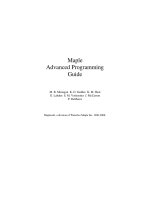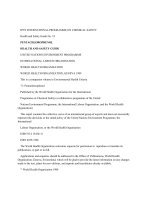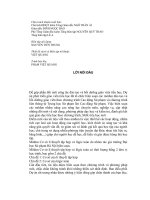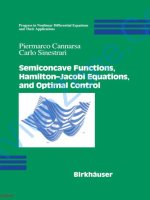William p ziemer weakly differentiable functions (1989) 978 1 4612 1015 3
Bạn đang xem bản rút gọn của tài liệu. Xem và tải ngay bản đầy đủ của tài liệu tại đây (19.53 MB, 323 trang )
Graduate Texts in Mathematics
J.H. Ewing
www.pdfgrip.com
120
Editorial Board
P.W. Gehring P.R. Halmos
Graduate Texts in Mathematics
I
2
3
4
5
6
7
8
9
to
II
12
13
14
15
16
17
18
19
20
21
22
23
24
25
26
27
28
29
30
31
32
33
34
35
36
37
38
39
40
41
42
43
44
45
46
47
TAKEUTIlZARING. Introduction to Axiomatic Set Theory. 2nd ed.
OXTOBY. Measure and Category. 2nd ed.
SCHAEFFER. Topological Vector Spaces.
HILTON/STAMMBACH. A Course in Homological Algebra.
MAC LANE. Categories for the Working Mathematician.
HUGHES/PIPER. Projective Planes.
SERRE. A Course in Arithmetic.
T AKEUTIlZARING. Axiomatic Set Theory.
HUMPHREYS. Introduction to Lie Algebras and Representation Theory.
COHEN. A Course in Simple Homotopy Theory.
CONWAY. Functions of One Complex Variable. 2nd ed.
BEALS. Advanced Mathematical Analysis.
ANDERSON/fuLLER. Rings and Categories of Modules.
GOLUBITSKy/GUILLEMIN. Stable Mappings and Their Singularities.
BERBERIAN. Lectures in Functional Analysis and Operator Theory.
WINTER. The Structure of Fields.
ROSENBLATT. Random Processes. 2nd ed.
HALMOS. Measure Theory.
HALMOS. A Hilbert Space Problem Book. 2nd ed., revised.
HUSEMOLLER. Fibre Bundles. 2nd ed.
HUMPHREYs. Linear Algebraic Groups.
BARNES/MACK. An Algebraic Introduction to Mathematical Logic.
GREUB. Linear Algebra. 4th ed.
HOLMES. Geometric Functional Analysis and its Applications.
HEwm/STRoMBERG. Real and Abstract Analysis.
MANES. Algebraic Theories.
KELLEY. General Topology.
ZARISKIISAMUEL. Commutative Algebra. Vol. I.
ZARISKIISAMUEL. Commutative Algebra. Vol. II.
JACOBSON. Lectures in Abstract Algebra I: Basic Concepts.
JACOBSON. Lectures in Abstract Algebra II: Linear Algebra.
JACOBSON. Lectures in Abstract Algebra III: Theory of Fields and Galois Theory.
HIRSCH. Differential Topology.
SPfIZER. Principles of Random Walk. 2nd ed.
WERMER. Banach Algebras and Several Complex Variables. 2nd ed.
KELLEY/NAMIOKA et a1. Linear Topological Spaces.
MONK. Mathematical Logic.
GRAUERT/FRrrzsCHE. Several Complex Variables.
ARVESON. An Invitation to C*-Algebras.
KEMENy/SNELL/KNAPP. Denumerable Markov Chains. 2nd ed.
APOSTOL. Modular Functions and Dirichlet Series in Number Theory.
SERRE. Linear Representations of Finite Groups.
GILLMAN/JERISON. Rings of Continuous Functions.
KENDIG. Elementary Algebraic Geometry.
LoEVE. Probability Theory I. 4th ed.
LoSVE. Probability Theory II. 4th ed.
MOISE. Geometric Topology in Dimensions 2 and 3.
continued after Index
www.pdfgrip.com
William P. Ziemer
Weakly Differentiable
Functions
Sobolev Spaces and Functions of
Bounded Variation
Springer Science+Business Media, LLC
www.pdfgrip.com
William P. Ziemer
Department of Mathematics
Indiana University
Bloomington, IN 47405
USA
Editorial Board
J. H. Ewing
F. W. Gehring
P. R. Halmos
Department of
Mathematics
Indiana University
Bloomington, IN 47405
USA
Department of
Mathematics
University of Michigan
Ann Arbor, MI 48109
USA
Department of
Mathematics
Santa Clara University
Santa Clara, CA 95053
USA
With I iIIustration.
Mathematics Subject Classifications (1980): 46-E35, 26-B30, 31-B15
Library of Congress Cataloging-in-Publication Data
Ziemer, William P.
Weakly differentiable functions: Sobolev spaces and functions of
bounded variation I William P. Ziemer.
p.
cm.-(Graduate texts in mathematics; 120)
Bibliography: p.
Includes index.
ISBN 978-1-4612-69115-4
ISBN 978-1-4612-1015-3 (eBook)
DOI 10.1007/978-1-4612-1015-3
1. Sobolev spaces.
II. Series.
QA323.Z53 1989
515'.73-dc20
2. Functions of bounded variation.
1. Title.
89-10072
Printed on acid-free paper.
© 1989 Springer Science+Business Media New York
Originally published by Springer-Verlag Berlin Heidelberg New York in 1989
Softcover reprint ofthe hardcover Ist edition 1989
Ali rights reserved. This work may not be translated or copied in whole or in part without the
written permission of the publisher written permission of the publisher (Springer-Science+
Business Media, LLC), except for brief excerpts in counection with reviews or scholarly analysis.
Use in connection with any form of information storage and retrieval, electronic adaptation,
computer software, or by similar or dissimilar methodology now known or hereafter developed
is forbidden. The use of general descriptive names, trade narnes, trademarks, etc. in this publication,
even if the former are not especially identified, is not to be taken as a sign that such names, as understood
by the Trade Marks and Merchandise Marks Act, may accordingly be used freely by
anyone.
Camera-ready copy prepared using LaTp.x.
9 8 765
432 1
www.pdfgrip.com
To Suzanne
www.pdfgrip.com
Preface
The term "weakly differentiable functions" in the title refers to those integrable functions defined on an open subset of R n whose partial derivatives
in the sense of distributions are either LP functions or (signed) measures
with finite total variation. The former class of functions comprises what
is now known as Sobolev spaces, though its origin, traceable to the early
1900s, predates the contributions by Sobolev. Both classes of functions,
Sobolev spaces and the space of functions of bounded variation (BV functions), have undergone considerable development during the past 20 years.
From this development a rather complete theory has emerged and thus has
provided the main impetus for the writing of this book. Since these classes
of functions play a significant role in many fields, such as approximation
theory, calculus of variations, partial differential equations, and non-linear
potential theory, it is hoped that this monograph will be of assistance to a
wide range of graduate students and researchers in these and perhaps other
related areas. Some of the material in Chapters 1-4 has been presented in
a graduate course at Indiana University during the 1987-88 academic year,
and I am indebted to the students and colleagues in attendance for their
helpful comments and suggestions.
The major thrust of this book is the analysis of pointwise behavior of
Sobolev and BV functions. I have not attempted to develop Sobolev spaces
of fractional order which can be described in terms of Bessel potentials,
since this would require an effort beyond the scope of this book. Instead,
I concentrate on the analysis of spaces of integer order which is largely
accessible through real variable techniques, but does not totally exclude
the use of Bessel potentials. Indeed, the investigation of pointwise behavior
requires an analysis of certain exceptional sets and they can be conveniently
described in terms of elementary aspects of Bessel capacity.
The only prerequisite for the present volume is a standard graduate
course in real analysis, drawing especially from Lebesgue point theory and
measure theory. The material is organized in the following manner. Chapter 1 is devoted to a review of those topics in real analysis that are needed
in the sequel. Included here is a brief overview of Lebesgue measure, V'
spaces, Hausdorff measure, and Schwartz distributions. Also included are
sections on covering theorems and Lorentz spaces-the latter being necessary for a treatment of Sobolev inequalities in the case of critical indices.
Chapter 2 develops the basic properties of Sobolev spaces such as equivalent formulations of Sobolev functions and their behavior under the opera-
www.pdfgrip.com
Preface
viii
tions of truncation, composition, and change of variables. Also included is a
proof of the Sobolev inequality in its simplest form and the related RellichKondrachov Compactness Theorem. Alternate proofs of the Sobolev inequality are given, including the one which relates it to the isoperimetric
inequality and provides the best constant. Limiting cases of the Sobolev
inequality are discussed in the context of Lorentz spaces.
The remaining chapters are central to the book. Chapter 3 develops the
analysis of pointwise behavior of Sobolev functions. This includes a discussion of the continuity properties of functions with first derivatives in
LP in terms of Lebesgue points, approximate continuity, and fine continuity, as well as an analysis of differentiability properties of higher order
Sobolev functions by means of V-derivatives. Here lies the foundation for
more delicate results, such as the comparison of V-derivatives and distributional derivatives, and a result which provides an approximation for
Sobolev functions by smooth functions (in norm) that agree with the given
function everywhere except on sets whose complements have small capacity.
Chapter 4 develops an idea due to Norman Meyers. He observed that
the usual indirect proof of the Poincare inequality could be used to establish a Poincare-type inequality in an abstract setting. By appropriately
interpreting this inequality in various contexts, it yields virtually all known
inequalities of this genre. This general inequality contains a term which involves an element of the dual of a Sobolev space. For many applications,
this term is taken as a measure; it therefore is of interest to know precisely
the class of measures contained in the dual of a given Sobolev space. Fortunately, the Hedberg-Wolff theorem provides a characterization of such
measures.
The last chapter provides an analysis of the pointwise behavior of BV
functions in a manner that runs parallel to the development of Lebesgue
point theory for Sobolev functions in Chapter 3. While the Lebesgue point
theory for Sobolev functions is relatively easy to penetrate, the corresponding development for BV functions is much more demanding. The
intricate nature of BV functions requires a more involved exposition than
does Sobolev functions, but at the same time reveals a rich and beautiful
structure which has its foundations in geometric measure theory. After the
structure of BV functions has been developed, Chapter 5 returns to the
analysis of Poincare inequalities for BV functions in the spirit developed
for Sobolev functions, which includes a characterization of measures that
belong to the dual of BV.
In order to place the text in better perspective, each chapter is concluded with a section on historical notes which includes references to all
important and relatively new results. In addition to cited works, the Bibliography contains many other references related to the material in the
text. Bibliographical references are abbreviated in square brackets, such as
[DLJ. Equation numbers appear in parentheses; theorems, lemmas, corollaries,and remarks are numbered as a.b.c where b refers to section b in chapter
www.pdfgrip.com
ix
Preface
a, and section a.b refers to section b in chapter a.
I wish to thank David Adams, Robert Glassey, Tero Kilpeliiinen,
Christoph Neugebauer, Edward Stredulinsky, Tevan Trent, and William
K. Ziemer for having critically read parts of the manuscript and supplied
many helpful suggestions and corrections.
WILLIAM
www.pdfgrip.com
P.
ZIEMER
Contents
Preface
vii
1 Preliminaries
1.1
1.2
1.3
1.4
1.5
1.6
1
Notation
Inner product of vectors
Support of a function
Boundary of a set
Distance from a point to a set
Characteristic function of a set
Multi-indices
Partial derivative operators
Function spaces-continuous, Holder continuous,
Holder continuous derivatives
Measures on Rn
Lebesgue measurable sets
Lebesgue measurability of Borel sets
Suslin sets
Covering Theorems
Hausdorff maximal principle
General covering theorem
Vitali covering theorem
Covering lemma, with n-balls whose radii vary in
Lipschitzian way
Besicovitch covering lemma
Besicovitch differentiation theorem
Hausdorff Measure
Equivalence of Hausdorff and Lebesgue measures
Hausdorff dimension
LP-Spaces
Integration of a function via its distribution
function
Young's inequality
Holder's and Jensen's inequality
Regularization
LP-spaces and regularization
www.pdfgrip.com
1
3
7
15
18
21
Contents
xii
1. 7
Distributions
Functions and measures, as distributions
Positive distributions
Distributions determined by their local behavior
Convolution of distributions
Differentiation of distributions
1.8 Lorentz Spaces
Non-increasing rearrangement of a function
Elementary properties of rearranged functions
Lorentz spaces
O'Neil's inequality, for rearranged functions
Equivalence of V-norm and (p,p)-norm
Hardy'S inequality
Inclusion relations of Lorentz spaces
Exercises
Historical Notes
2 Soholev Spaces and Their Basic Properties
2.1
2.2
2.3
2.4
2.5
2.6
Weak Derivatives
Sobolev spaces
Absolute continuity on lines
LP-norm of difference quotients
Truncation of Sobolev functions
Composition of Sobolev functions
Change of Variables for Sobolev Functions
Rademacher's theorem
Bi-Lipschitzian change of variables
Approximation of Sobolev Functions by Smooth
Functions
Partition of unity
Smooth functions are dense in Wk,p
Sobolev Inequalities
Sobolev's inequality
The Rellich-Kondrachov Compactness Theorem
Extension domains
Bessel Potentials and Capacity
Riesz and Bessel kernels
Bessel potentials
Bessel capacity
Basic properties of Bessel capacity
Capacitability of Suslin sets
Minimax theorem and alternate formulation of
Bessel capacity
www.pdfgrip.com
23
26
37
39
42
42
49
53
55
61
64
Contents
xiii
Metric properties of Bessel capacity
The Best Constant in the Sobolev Inequality
Co-area formula
Sobolev's inequality and isoperimetric inequality
2.8 Alternate Proofs of the Fundamental Inequalities
Hardy-Littlewood-Wiener maximal theorem
Sobolev's inequality for Riesz potentials
2.9 Limiting Cases of the Sobolev Inequality
The case kp = n by infinite series
The best constant in the case kp = n
An Loo-bound in the limiting case
2.10 Lorentz Spaces, A Slight Improvement
Young's inequality in the context of Lorentz spaces
Sobolev's inequality in Lorentz spaces
The limiting case
Exercises
Historical Notes
2.7
3 Pointwise Behavior of Sobolev Functions
3.1
3.2
3.3
3.4
3.5
3.6
3.7
3.8
Limits of Integral Averages of Sobolev Functions
Limiting values of integral averages except for
capacity null set
Densities of Measures
Lebesgue Points for Sobolev Functions
Existence of Lebesgue points except for capacity
null set
Approximate continuity
Fine continuity everywhere except for capacity null set
LP-Derivatives for Sobolev Functions
Existence of Taylor expansions LP
Properties of LP-Derivatives
The spaces Tk, tk, Tk,p, tk,p
The implication of a function being in Tk,p at all
points of a closed set
An LP- Version of the Whitney Extension Theorem
Existence of a Coo function comparable to the
distance function to a closed set
The Whitney extension theorem for functions in
Tk,p and tk,p
An Observation on Differentiation
Rademacher's Theorem in the LP-Context
A function in Tk,p everywhere implies it is in
tk,p almost everywhere
www.pdfgrip.com
76
83
88
96
103
108
112
112
116
118
126
130
136
142
145
xiv
Contents
The Implications of Pointwise Differentiability
Comparison of V-derivatives and distributional
derivatives
If U E tk,P(x) for every x, and if the
LP-derivatives are in V, then u E Wk,p
3.10 A Lusin-Type Approximation for Sobolev Functions
Integral averages of Sobolev functions are uniformly
close to their limits on the complement of sets
of small capacity
Existence of smooth functions that agree with Sobolev
functions on the complement of sets of
small capacity
3.11 The Main Approximation
Existence of smooth functions that agree with
Sobolev functions on the complement of sets of
small capacity and are close in norm
Exercises
Historical Notes
3.9
4 Poincare Inequalities-A Unified Approach
4.1
4.2
4.3
4.4
4.5
4.6
4.7
Inequalities in a General Setting
An abstract version of the Poincare inequality
Applications to Sobolev Spaces
An interpolation inequality
The Dual of Wm,p(n)
The representation of (W~,p(n))*
Some Measures in (W~,p(n))*
Poincare inequalities derived from the abstract
version by identifying Lebesgue and Hausdorff
measure with elements in (Wm,p(n))*
The trace of Sobolev functions on the boundary of
Lipschitz domains
Poincare inequalities involving the trace of
a Sobolev function
Poincare Inequalities
Inequalities involving the capacity of the set on
which a function vanishes
Another Version of Poincare's Inequality
An inequality involving dependence on the set on
which the function vanishes, not merely on its
capacity
More Measures in (wm,p(n))*
Sobolev's inequality for Riesz potentials involving
www.pdfgrip.com
146
153
159
168
175
177
178
182
185
188
193
196
198
Contents
xv
measures other than Lebesgue measure
Characterization of measures in (wm,p(Rn))*
4.8 Other Inequalities Involving Measures in (Wk,P)*
Inequalities involving the restriction of Hausdorff
measure to lower dimensional manifolds
4.9 The Case p = 1
Inequalities involving the L 1-norm of the gradient
Exercises
Historical Notes
5 Functions of Bounded Variation
5.1
5.2
5.3
5.4
5.5
5.6
5.7
Definitions
Definition of BV functions
The total variation measure IIDul1
Elementary Properties of BV Functions
Lower semicontinuity of the total variation measure
A condition ensuring continuity of the total
variation measure
Regularization of BV Functions
Regularization does not increase the BV norm
Approximation of BV functions by smooth functions
Compactness in L1 of the unit ball in BV
Sets of Finite Perimeter
Definition of sets of finite perimeter
The perimeter of domains with smooth boundaries
Isoperimetric and relative isoperimetric inequality for
sets of finite perimeter
The Generalized Exterior Normal
A preliminary version of the Gauss-Green theorem
Density results at points of the reduced boundary
Tangential Properties of the Reduced Boundary and the
Measure-Theoretic Normal
Blow-up at a point of the reduced boundary
The measure-theoretic normal
The reduced boundary is contained in the
measure-theoretic boundary
A lower bound for the density of IIDXEII
Hausdorff measure restricted to the reduced boundary
is bounded above by IIDXEII
Rectifiability of the Reduced Boundary
Countably (n - I)-rectifiable sets
Countable (n - 1)-rectifiability of the
measure-theoretic boundary
www.pdfgrip.com
207
209
214
217
220
220
222
224
228
233
237
243
Contents
xvi
5.8
The Gauss-Green Theorem
The equivalence of the restriction of Hausdorff
measure to the measure-theoretic boundary
and IIDXEII
The Gauss-Green theorem for sets of finite perimeter
5.9 Pointwise Behavior of BV Functions
Upper and lower approximate limits
The Boxing inequality
The set of approximate jump discontinuities
5.10 The Trace of a BV Function
The bounded extension of BV functions
Trace of a BV function defined in terms of the
upper and lower approximate limits of the
extended function
The integrability of the trace over the
measure-theoretic boundary
5.11 Sobolev-Type Inequalities for BV Functions
Inequalities involving elements in (BV(O))*
5.12 Inequalities Involving Capacity
Characterization of measure in (BV(O))*
Poincare inequality for BV functions
5.13 Generalizations to the Case p > 1
5.14 Trace Defined in Terms of Integral Averages
Exercises
Historical Notes
246
249
255
260
262
270
272
277
280
Bibliography
283
List of Symbols
297
Index
303
www.pdfgrip.com
1
Preliminaries
Beyond the topics usually found in basic real analysis, virtually all of the
material found in this work is self-contained. In particular, most of the information contained in this chapter will be well-known by the reader and
therefore no attempt has been made to make a complete and thorough presentation. Rather, we merely introduce notation and develop a few concepts
that will be needed in the sequel.
1.1
Notation
Throughout, the symbol n will generally denote an open set in Euclidean
space R n and 0 will designate the empty set. Points in Rn are denoted by
x = (Xl"'" x n ), where Xl E RI, 1 ~ i ~ n. If x, Y E Rn, the inner product
of X and y is
n
X· Y
= LXiYi
i=l
and the norm of X is
If u: n
---. RI
Ixi = (x· x)I/2.
is a function defined on
spt u
=
n, the
support of u is defined by
n n {x: u(x) =f. a},
where the closure of a set S c R n is denoted by S. If Sen, S compact
and also Sen, we shall write S cc n. The boundary of a set S is defined
by
as = S n (Rn - S).
For E
c
R n and x E R n , the distance from x to E is
d(x, E) = inf{lx -
YI : Y E E}.
It is a simple exercise (see Exercise 1.1) to show that
Id(x, E) - d(y, E)I ~ Ix - yl
whenever x, y E Rn. The diameter of a set E C Rn is defined by
diam(E) = sup{lx - yl : x, y E E},
www.pdfgrip.com
1. Preliminaries
2
and the characteristic function E is denoted by XE. The symbol
B(x, r) = {y : Ix -
yl < r}
denotes the open ball with center x, radius rand
B(x,r) = {y: Ix -
yl
~
r}
will stand for the closed ball. We will use a(n) to denote the volume of the
ball of radius 1 in Rn. If a = (all ... ' an) is an n-tuple of non-negative
integers, a is called a multi-index and the length of a is
n
and a! = al!a2!··· an!. The partial derivative operators are denoted by
Di = a / aXi for 1 ~ i ~ n, and the higher order derivatives by
D '" -- D"'1
1
...
D"'n _
n
-
aXl
"'1
al"'l
...
aXn"'n·
The gradient of a real-valued function u is denoted by
Du(x) = (Dlu(x), ... , Dnu(x)).
If k is a non-negative integer, we will sometimes use Dku to denote the
vector Dku = {D"'u}I"'I=k.
We denote by CO(n) the space of continuous functions on n. More generally, if k is a non-negative integer, possibly 00, let
ck(n) = {u: u:n
ci(n)
= Ck(n)
-+
Rl,D"'u E CO(n), 0 ~
n {u: spt
u compact, spt u
lal
~ k},
en},
and
Ck(IT) = ck(n)
n {u : D"'u has a continuous extension to IT, 0 ~ lal
~ k}.
Since n is open, a function u E Ck(n) need not be bounded on n. However,
if u is bounded and uniformly continuous on n, then u can be uniquely
extended to a continuous function on IT. We will use C k (n; Rm) to denote
the class of functions u: n -+ Rm defined on n whose coordinate functions
belong to Ck(n). Similar notation is used for other function spaces whose
elements are vector-valued.
www.pdfgrip.com
1.2. Measures on R n
3
If 0 < a ::; 1, we say that u is Holder continuous on
if there is a constant C such that
lu(x) - u(y) I ::; Clx - yl''',
n with
exponent a
x, yEn.
We designate by cO,"(n) the space of all functions u satisfying this condition on n. In case a = 1, the functions are called Lipschitz and the constant
C is denoted by Lip( u). For functions that possess some differentiability,
we let
Note that Ck,,,(O) is a Banach space when provided with the norm
sup sup
IDi3 u (x) - Di3 u (y) I
I
1.2
I
x - Y"
1i3I=k x,yHl
xi-y
+
max sup IDi3 u (x)l·
O~Ii319 xEn
Measures on Rn
For the definition of Lebesgue outer measure, we consider closed n-dimensional intervals
I = {x : ai ::; Xi ::; bi , i = 1, ... , n}
and their volumes
n
v(I) =
II (bi -
ai).
i=l
The Lebesgue outer measure of an arbitrary set E
lEI = inf
{f:
v(h) : E C
k=l
Uh,
c
R n is defined by
Ik an interval}
(1.2.1)
k=l
A set E is said to be Lebesgue measurable if
(1.2.2)
whenever A eRn.
The reader may consult a standard text on measure theory to find that
the Lebesgue measurable sets form a cr-algebra, which we denote by A; that
is
(i) 0,Rn E A.
(ii) If E l , E 2 , ..• E A, then
00
(1.2.3)
www.pdfgrip.com
1. Preliminaries
4
(iii) If E E A, then R n
E E A.
-
Observe that these conditions also imply that A is also closed under countable intersections. It follows immediately from (1.2.2) that sets of measure
zero are measurable. Also recall that if E 1 , E 2 , • •• are pairwise disjoint
measurable sets, then
(1.2.4)
i=l
i=l
Moreover, if El C E2 C ... are measurable, then
(1.2.5)
and if El :J E2 :J ... , then
(1.2.6)
provided that IEkl < 00 for some k.
Up to this point, we find that Lebesgue measure possesses many of the
continuity properties that are essential for fruitful applications in analysis.
However, at this stage we do not yet know whether the a-algebra, A, contains a sufficiently rich supply of sets to be useful. This possible objection
is met by the following result.
1.2.1. Theorem. Each closed set CeRn is Lebesgue measurable.
In view of the fact -that the Borel subsets of Rn form the smallest aalgebra that contains the closed sets, we have
1.2.2. Corollary. The Borel sets of Rn are Lebesgue measurable.
Proof of Theorem 1.2.1. Because of the subadditivity of Lebesgue measure, it suffices to show that for a closed set CeRn,
(1.2.7)
whenever A c Rn. This will follow from the following property of Lebesgue
outer measure, which follows easily from (1.2.1):
IAUBI
= IAI + IBI
(1.2.8)
whenver A, BERn with d(A,B) = inf{lx-yl : x E A, y E B} > O. Indeed,
it is sufficient to establish that IAUBI ~ IAI+IBI. For this purpose, choose
e > 0 and let
UIk
00
Au B C
where
k=l
www.pdfgrip.com
1.2. Measures on R'"
5
00
L:v(h)
< IAUBI +e.
(1.2.9)
i=1
Because d(A, B)
> 0, there exists disjoint open sets U and V such that
AeU,
BeV.
(1.2.10)
Clearly, the covering of A U B by {Ik} can be modified so that, for each k,
(1.2.11)
and that (1.2.9) still remains valid. However, (1.2.10) and (1.2.11) imply
L: v(Ik) ~ IAI + IBI·
00
i=1
In order to prove (1.2.7), consider A
{x: d(x, G) :5 Iii}. Note that
d( A - Gi , A
e
Rn with IAI
< 00 and let Gi
=
n G) > 0
and therefore, from (1.2.8),
(1.2.12)
The proof of (1.2.7) will be concluded if we can show that
.lim
t--+oo
IA -
Gil =
IA -
GI·
Note that we cannot invoke (1.2.5) because it is not known that A - Gi is
measurable since A is an arbitrary set, perhaps non-measurable. Let
Ti
= An {x: i ~ 1 < d(x, G) :5 ~ }
(1.2.13)
and note that since G is closed,
(1.2.14)
which in turn, implies
00
IA-GI :5IA-Gj l+ L:ITil.
(1.2.15)
i=j
Hence, the desired conclusion will follow if it can be shown that
(1.2.16)
www.pdfgrip.com
1. Preliminaries
6
Ii - il
To establish this, first observe that d(Ti' T j ) > 0 if
obtain from (1.2.8) that for each positive integer m,
IQ T2il = ~ IT2il ~ IAI <
t
I,=1 T2i-11 =
10 T2i- 11~ IAI
,=1
~ 2. Thus, we
00,
<
00.
This establishes (1.2.16) and thus concludes the proof.
o
1.2.3. Remark. Lebesgue measure and Hausdorff measure (which will be
introduced in Section 1.4) will meet most of the applications that occur
in this book, although in Chapter 5, it will be necessary to consider more
general measures. We say that J.L is a measure on R n if J.L assigns a nonnegative (possibly infinite) number to each subset of R n and J.L(0) = O. It
is also accepted terminology to call such a set function an outer measure.
Following (1.2.2), a set E is called J.L-measurable if
J.L(A) = J.L(A n E)
+ J.L(A n (Rn
- E))
whenever A c Rn. A measure J.L on R n is called a Borel measure if every
Borel set is J.L-measurable. A Borel measure J.L with the properties that each
subset of Rn is contained within a Borel set of equal J.L measure and that
J.L(K) < 00 for each compact set KeRn is called a Radon measure.
Many outer measures defined on Rn have the property that the Borel sets
are measurable. However, it is sometimes necessary to consider a larger (J'algebra of sets, namely, the Buslin sets, (often referred to as analytic sets).
They have the property of remaining invariant under continuous mappings
on R n , a property not enjoyed by the Borel sets. The Suslin sets of R n can
be defined in the following manner. Let N denote the space of all infinite
sequences of positive integers topologized by the metric
where {ail and {bi} are elements of N. Let Rn x N be endowed with the
product topology. If
p : R n x N ---+ R n
is the projection defined by p(x, a) = x, then a Suslin set of R n can be
defined as the image under p of some closed subset of R n x N.
The main reason for providing the preceding review of Lebesgue measure
is to compare its development with that of Hausdorff measure, which is
not as well known as Lebesgue measure but yet is extremely important in
geometric analysis and will play a significant role in the development of
this monograph.
www.pdfgrip.com
1.3. Covering Theorems
1.3
7
Covering Theorems
Before discussing Hausdorff measure, it will be necessary to introduce several important and useful covering theorems, the first of which is based on
the following implication of the Axiom of Choice.
Hausdorff Maximal Principle. If E is a family of sets (or a collection
of families of sets) and if {UF : F E F} E E for any subfamily F of E
with the property that
F
e
G or G
e
F
whenever F, G E F,
then there exists E e E which is maximal in the sense that it is not a subset
of any other member of E.
The following notation will be used. If B is a closed ball of radius r, let
with radius 5r.
E denote the closed ball concentric with B
1.3.1. Theorem. Let 9 be a family of closed balls with
R == sup{diamB : B E 9} <
Then there is a subfamily F
e9
of pairwise disjoint elements such that
{UB : B E 9}
In fact, for each B E
B eEl.
9
00.
e {UE : B
E F}.
there exists Bl E F such that B n Bl =I- 0 and
Proof. We determine F as follows. For j = 1,2, ... let
9j = 9 n
{B :23R< diam B<- 23-l!
1} ,
and observe that 9 = U~19j. Now proceed to define F j e 9j inductively
as follows.
Let Fl e 91 be an arbitrary maximal subcollection of pairwise disjoint
elements. Such a collection exits by the Hausdorff maximal principle. Assuming that F l , F 2 , •.. , Fj -1 have been chosen, let F j be a maximal pairwise disjoint sub collection of
9j n { B: B n B' =
0 whenever B' E
UFi
j-l
,=1
}
.
(1.3.1)
Thus, for each BE 9j, j ~ 1, there exists Bl E UtlFi such that BnB l =I0. For if not, the family FJ consisting of B along with all elements of F j
www.pdfgrip.com
1. Preliminaries
8
would be a pairwise disjoint subcollection of (1.3.1), thus contradicting the
maximality of Fj . Moreover,
diam B
which implies that Be
fh.
:s;
2~1
= 2
~ :s; 2 diam Bl
Thus,
and the conclusion holds by taking
00
o
1.3.2. Definition. A collection 9 of closed balls is said to cover a set
E c R n finely if for each x E E and each e > 0, there exists B(x, r) E 9
and r < e.
1.3.3. Corollary. Let E c R n be a set that is covered finely by g, where
9 and F are as in Theorem 1.3.1. Then,
E - {UB : B E F*} c {UB : B E F - F*}
for each finite collection F* C F.
Proof. Since R n - {UB : B E F*} is open, for each x E E - {UB : B E F*}
there exists BEg such that x E Band B n [{UB : B E F*}l = 0. From
Theorem 1.3.1, there is Bl E F such that B n Bl :f. 0 and Bl ~ B. Now
Bl ¢ F* since B n Bl :f. 0 and therefore
o
x E {UB : B E F - F*}.
The next result addresses the question of determining an estimate for
the amount of overlap in a given family of closed balls. This will also be
considered in Theorem 1.3.5, but in the following we consider closed balls
whose radii vary in a Lipschitzian manner. The notation Lip(h) denotes
the Lipschitz constant of the mapping h.
°
1.3.4. Theorem. Let S cUe R n and suppose h : U ---+ (0,00) is Lipschitz
with Lip(h) :s; A. Let 0: > 0, /3 > with AO: < 1 and A/3 < 1. Suppose the
collection of closed n-balls {B(s, h(s)) : s E S} is disjointed. Let
Sx = S n {s : B(x, o:h(x)) n B(s, /3h(s),)
www.pdfgrip.com
:f. o}.
9
1.3. Covering Theorems
Then
(1 - >"(3)/(1 + >..a) ::5 h(x)/h(s) ::5 (1 + >"(3)/(1 - >..a)
(1.3.2)
whenever s E Sx and
where card(Sx) denotes the number of elements in Sx.
Proof. If s E Sx, then clearly Ix -
sl ::5 ah(x) +
Ih(x) - h(s)1 ::5 >"Ix -
f3h(s) and therefore
sl ::5 >..ah(x) + >"f3h(s),
(1 - >..(3)h(s) ::5 (1 + >..a)h(x),
(1- >..a)h(x) ::5 (1 + >..(3)h(s).
(1.3.3)
Now,
Ix -
where -y
sl +
h(s) ::5 ah(x) + (13 + l)h(s)
::5 o:h(x) + (13 + 1)[(1 + >"0:)/(1 - >..(3)]h(x)
=-yh(x)
= 0: + (13 + 1)(1 + >"0:)/(1 -
>../3). Hence
B(s,h(s)) C B(x,-yh(x)) whenever s E Sx'
Since {B(s, h(s))} is a disjoint family,
L
IB(s, h(s))1 ::5IB(s,-yh(x))1
sESz
or from (1.3.3)
card(Sx)a(n)[(l+>"o:)(l->"/3)-lh(x)]n::5
L
o:(n)h(s)n ::5 o:(n)[-yh(x)]n. 0
sESz
We now consider an arbitrary collection of closed balls and find a subcover which is perhaps not disjoint, but whose elements have overlap which
is controlled.
1.3.5. Theorem. There is a positive number N > 1 depending only on n
so that any family 8 of closed balls in Rn whose cardinality is no less than
Nand R = sup{ r : B( a, r) E 8} < 00 contains disjointed subfamilies 8 1 ,
8 2 , ••• , 8N such that if A is the set of centers of balls in 8, then
N
AC
U{UB : B E 8
i=1
www.pdfgrip.com
i }.
1. Preliminaries
10
Proof.
Step I. Assume A is bounded.
Choose Bl = B(ab rd with rl > ~R. Assuming we have chosen B l , ... ,
Bj-l in B where j ~ 2 choose B j inductively as follows. If Aj = A '"
Bi = 0, then the process stops and we set J = j. If Aj f. 0, continue
by choosing B j = B( aj, r j) E B so that aj E Aj and
uf:t
3
rj> 4sup{r: B(a,r) E B,a E A j }.
(1.3.4)
If Aj f. 0 for all j, then we set J = +00. In this case limj-+oo rj
because A is bounded and the inequalities
=0
imply that
{B(aj,rj/3) : 1 ~ j ~ J} is disjointed.
In case J
(1.3.5)
< 00, we clearly have the inclusion
A C {UBj : 1 ~ j ~ J}.
(1.3.6)
This is also true in case J = +00, for otherwise there would exist B(a, r) E
B with a E n~lAj and an integer j with rj ~ 3r/4, contradicting the
choice of B j •
Step II. We now prove there exists an integer M (depending only on n)
such that for each k with 1 ~ k < J, M exceeds the number of balls Bi
with 1 ~ i ~ k and Bi n Bk f. 0.
First note that if ri < lOrk, then
B(ai' ri/3) C B(ak' 15rk)
because if x E B(ai' ri/3),
Ix -
Ix -
~ lOrk/3
+ lai - akl
+ ri + rk
~ 43rk/3
< 15rk·
akl ~
ail
Hence, there are at most (60)n balls Bi with
1
~
i ~ k, Bi
n Bk f. 0, and ri
~
because, for each such i,
B(ai' ri/3) C B(ak' 15rk),
and by (1.3.4) and (1.3.5)
www.pdfgrip.com
10rk









